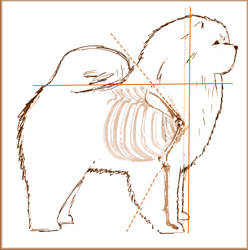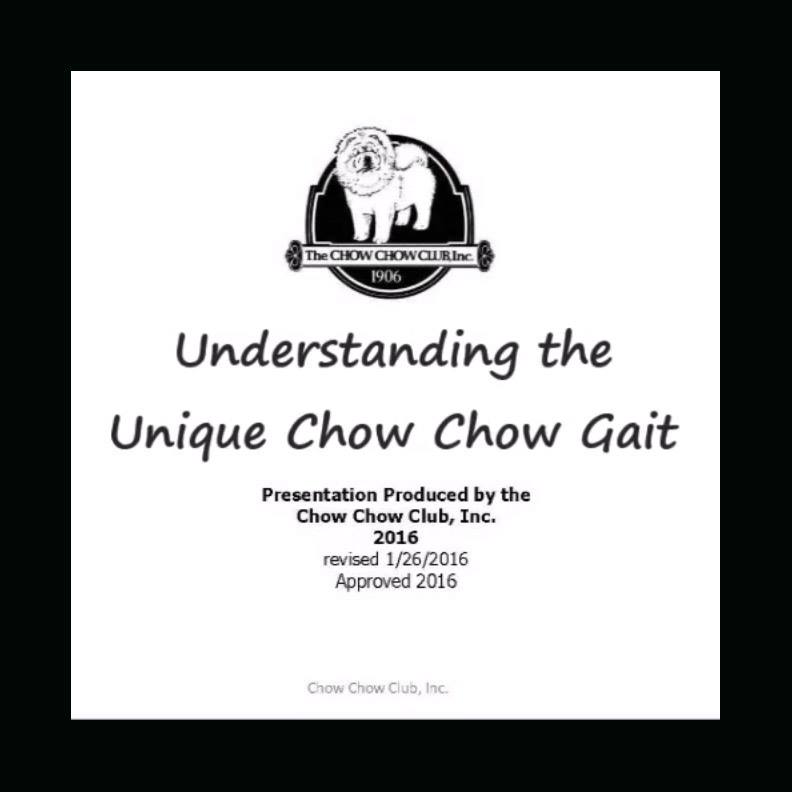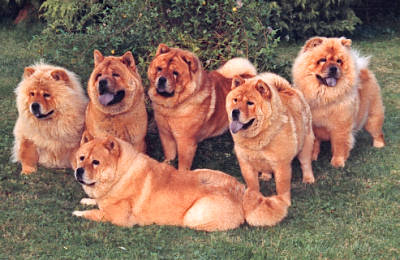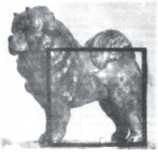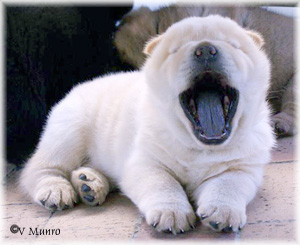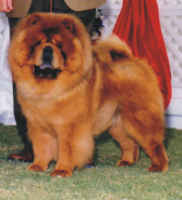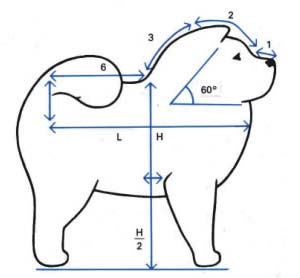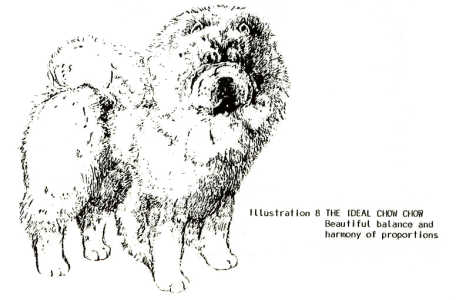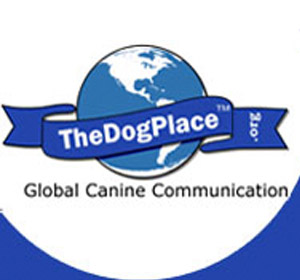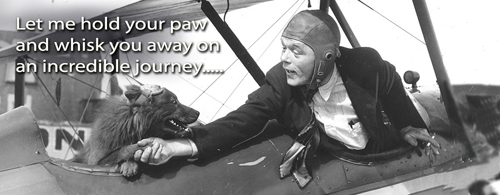Chow Chow Africa education
Best for the breed -
breeders And Judges Education
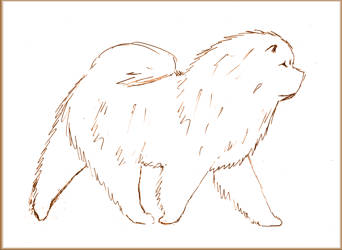
Retaining Stilted / Pendulum Gait -
A Different Angle.
by Bernice Leroy, Ciao Chows, South Africa
This article first appeared in The
World of Chows in 2007 and 2008 - ISBN 978-90-76717-29-6 : publisher www.bbpress.nl
Bernice Leroy has been involved with chow chows since 1995. Whilst showing on a limited basis,
she has bred and owned "in Show" winners and championed
26 chow chows, amongst which 17 homebreds since 2002.
She has been privileged to count amongst her mentors some of
the chow chow world's, as well as some of dogdom's, greats
- attributing her understanding to this indepth and generous mentorship.
There is international lament for loss of the Chow Chow’s unique and millenniums old stilted / pendulum gait. This being a major defining characteristic of our breed, it is a very serious matter. Few can explain technically why the Chow Chow stilts, and equally few have actually seen correct stilted / pendulum gait. If the greater number of breeders cannot technically understand what exactly brings about stilted / pendulum gait, how can they produce it, select for it or educate judges? If the greater number of judges do not technically understand or see correct stilted / pendulum gait, how can they accurately reward it? Most are looking for a quick and easy answer, they are ‘too busy’ to do in-depth research – typical of our fast-paced instant gratification society. Vague explanations such as the misleading half-truth ‘it is because of the straighter stifle’ lead to atrocities such as the 2008 apparently poorly researched program aired on the BBC, supported by predominantly laymen, Animal Rights Activists and, at least initially, inappropriately responded to by UK Kennel Club.
FRONT
As with the stilted/pendulum rear gait, there is a growing voice of concern amongst knowledgeable breeders, specialist and all-breeds judges with regards to the prevalence of incorrect fronts on Chow Chows. Is it just by chance that along with the loss of the true stilted gait in the rear, we have incorrect fronts escalating? Could it just be coincidence that elbow health statistics for the breed are not good as incorrect fronts increase? Why do we say that the front assembly will affect the rear movement? Movement of any dog depends upon front and rear assemblies moving in sync with one another – be it because of correct balance or compensating balance. The rare Chow Chow with its front and rear assemblies, actual bones and correct angulations all in excellent balance and correctly placed, will also have that elusive free stilt along with a shorter stride.
 Illustration
1 Illustration
1 Typical pendulum/stilted gait, shorter striding, free movement of a square Chow Chow with excellent balance. |
|
BREED
STANDARDS
The breed standards around the world call for:
Proud, dignified bearing, upstanding dog of Arctic type. Neck
– strong, full, not short, set well on shoulders and slightly
arched, of sufficient length to carry the head proudly, well above
the top line when standing at attention. Shoulders muscular and
sloping. Elbow joints set well back along side the chest wall.
Forelegs perfectly straight. Length of upper arm never less than
length of shoulder blade. A narrow chest is a serious fault.
Let us first look at the correct front assembly. On a dog which has very moderate angulations such as the Chow Chow, how would one anatomically achieve proud carriage with head well above topline when at attention, an upstanding dog with straight legs, a square dog with free movement?
Illustration 2 shows the correct front assembly. Point of sternum (vertical solid line) definitely in front of point of shoulder (vertical dotted line). Length of upper arm never shorter than length of shoulderblade. Shoulderblade layback of about 55-60° and a corresponding 55-60° lay forward of the upper arm, creating a 110-120° overall front angulation. (angled dotted line) (Solid horizontal line = topline)
Evaluation Hint:
When evaluating the free standing Chow whilst it is paying attention
to something, step to a comfortable side view. Do not focus on a
foot out of place, but on the entire dog – take note of the
way the Chow uses its skeleton to achieve for itself a naturally
comfortable balance of bodyweight. Then go ‘lay hands on’
the Chow to confirm visual evaluation.
The following major front assembly faults (no, these are not just
failings!) have a definite impact on correct, free striding, stilted
rear gait and should be selected against when breeding and in the
show ring:
The poorly placed front assembly (point of sternum behind point
of shoulder.) (Illustration 3, 4 and 5)
The short upper arm (Illustration 3 and 4)
The straight upper arm (Illustration 5)
The straight shoulder (Illustration 4)
(When evaluating a rough Chow Chow, one should never base a final
evaluation just on a visual assessment, as all of these are disguised
fairly well by coat and handler.)
IMPACT OF INCORRECT FRONTS
Head carriage:
* When the front assembly is placed too far forward along the ribcage
or the upper arm is short, the set on of neck is affected, thus
head carriage is affected. The body compensates to balance the free
standing dog to carry its head ‘in front of ’ the body,
not on the shoulders, giving a ‘top heavy’ carriage.
With more angulation all around, these dogs can show some length
of neck, though carriage remains ‘in front of’ the dog.
(Illustrations 3 and 4)
* Combining a front too far forward and the short upper arm, as is much too commonly observed, we have a dog with ‘little neck’ and poor head carriage. (Illustration 3)
* With the straight shoulder, the head cannot be lifted above the topline. Again, a ‘top-heavy’ appearance with the head in front of the body. (Illustration 4)
* The dog with the front too far forward, straight upper arm, but of correct length and reasonable angulation will tend to carry the head well on the shoulders. This dog is often rewarded/selected for, as the prouder carriage impresses. Pleasing carriage standing maybe, but in movement, this dog will manifest its faulty front. (Illustration 5)
Elbows/Pasterns:
* Because of the way the body has to support much of its weight
(centre of gravity) – with a front assembly that is placed
too far forward as well as with the short upper arm and the straight
shoulder – more weight and stress is placed on elbows and
pasterns, both standing and in movement. The result is weaker/softer
pasterns (manifest both in ‘down on the pastern’ and
‘east-west’ standing) and one of the contributing factors
to poor elbow health due to additional strain added to the elbow
joints.
(Illustration 3, 4 and 5)
Free standing body:
* With the front assembly too far forward the body is elongated
– definitely not square.
(Illustrations 3, 4 and 5)
* The short upper arm contributes to the ‘higher in the rear’ impression. (Illustration 3 and 4 – if the rear was moved more underneath the dog, it would become more noticeable.)
* The straight shoulder markedly increases length of back. (Illustration 4)
* On free standing, the dog with the front too far forward will stand with its front feet either fairly close or very close together – often with a marked ‘east-west’ stance. More barrel ribbed and fat dogs with an incorrect front will have apparently normal or even more width between the legs. Upon hands-on examination, no forechest will be emerging from between the front legs. On the longer coated rough, much hair might be emerging from between the front legs, thus a hands-on approach is essential. (Illustrations 9, 10 and 11)
* The dog with the front too far forward, straight but correct length of upper arm and reasonable angulation may look glamorous in carriage, yet no forechest will be emerging from between the front legs and it will be too long in body. (Illustration 5 and 11)
* The dog with the combination of front too far forward and short upper arm will most likely have soft pasterns. This will give the impression of the front legs forming a ‘c’ in stead of a straight line underneath the shoulders, when viewed from the side. The over angulated dogs with these faults tend to stand ‘rocking horse’ – the front forward to support the body and a compensating rear stretched back. (Illustration 3)
* The dog with front too far forward, short upper arm and straight shoulder will tend to stand with feet underneath the chest and weak pasterns to achieve a balance of body and head weight. (Illustration 4)
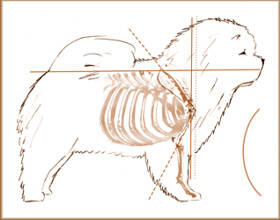 |
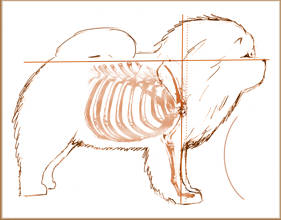 |
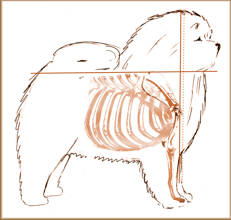 |
||
| Illustration 3 | Illustration 4 | Illustration 5 |
Gait:
* With any one or a combination of these – the front assembly
too far forward, the short upper arm, the straight upper arm and
straight shoulder – the stride will be foreshortened markedly
in front (directly proportional to the extent of the fault). Combine
this with the called for angulation on the Chow Chow and this dog
will have definite restricted front movement (not free moving) and
in compensation it will take shorter strides in the rear but it
is seldom that this dog will be stilting correctly, if at all. At
a slow pace this Chow Chow will not be extending fully in the rear
(appear sickle hocked, to varying degrees), (Illustration 6) or, on faster movement, the dog may extend more fully in the rear,
but would have to flip the front feet up (padding) – to compensate
in front.
(Illustration 7)
* Whilst head carriage goes forward and lower during movement on a correct dog (Illustration 1), head carriage during movement on Chow Chows with front issues, is too low (‘in front of the dog’), worse so in combination of faults. (Illustrations 6 and 7)
* Often the gait of any of these dogs is remarked upon as ‘it looks like the rear wants to overtake the front’ – which it probably does want to do!
* The space to move more freely underneath itself because of length of body, makes it appear that this ‘longer bodied’ dog of incorrect structural balance moves ‘better’ (that is – easier) than its shorter bodied companion, however, that definitely does not make the movement (or the Chow Chow) correct!
* Because of the compensation by nature, the angulations and bones on front and rear assemblies of these Chows are most often in complete imbalance. Although these dogs will have a short stride in the rear, they are most likely not stilting correctly (not have the correct pendulum movement) – due to incorrect angulations and compensation. This is not correct free moving, full extension stilted gait. This imbalance causes the dog to tire easily, and this cannot be an endurance dog, which the Chow Chow historically should be.
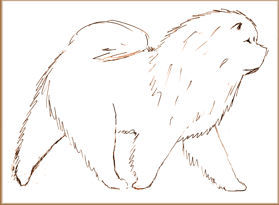 |
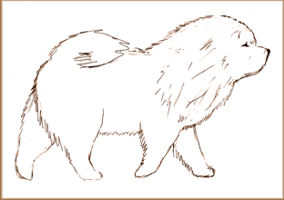 |
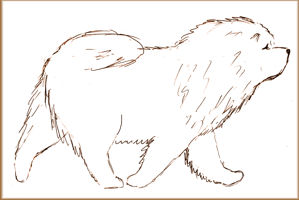 |
||
| Illustration
1a Full extension front & rear, short stride, free gait. |
Illustration
6a Restricted front and compensating rear movement |
Illustration
7a
|
Much coat often hides the extent and type of stifle movement of the restricted rear stride which compensates for incorrect fronts. (Illustrations 6 and 7). This incorrect movement is rewarded, taught and selected for as stilted gait, yet it is as serious a fault on a Chow Chow as the Chow that obviously drives from the stifle (bicycling).
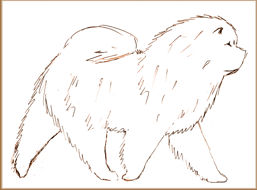 |
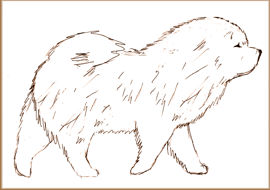 |
 |
||
| Illustration 1 | Illustration 6 | Illustration 7 |
ADJUSTING
OUR VIEWPOINT
Perhaps aiding in the promotion of these faults in the show ring is the fact that our Chow Chows are traditionally presented three-quarters head-on in the show ring. Whilst judges can step back and see a profile view, they’d have to step away and change their complete angle to see all dogs in comparison in profile. Should the judges be automatically exposed to the side view as in most other breeds, they will more often see the incorrect silhouettes and select for more correct structure. The judges have the prerogative to demand dogs presented for side view, as some have done.
Compare the same four dogs presented ¾ head on and then sideways. Notice how much more defined incorrect front structure is, from the side view.
 |
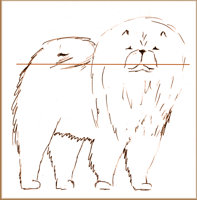 |
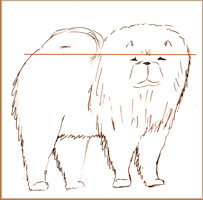 |
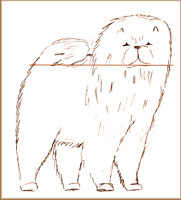 |
|||
| Illustration 8 | Illustration 9 | Illustration 10 | Illustration 11 |
Evaluation
hint – ¾ front view:
Notice how there is no forechest emerging from between the front
legs on Illustrations 9 – 11. Being able to explain why helps
one to establish understanding. Notice in Illustration 11 that the
shape of the front is more visible due to a shorter coat, in comparison
with much mane in
Illustrations 9 and 10. All three these dogs have the same ‘missing
forechest’. In evaluating real dogs for a given purpose, one
should always have hands on approach and feel underneath both a
short front mane and the long front mane.
 |
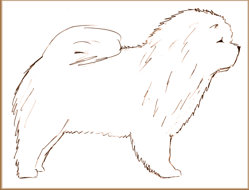 |
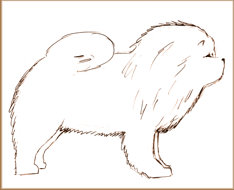 |
 |
|||
| Illustration 12 | Illustration 13 | Illustration 14 | Illustration 15 |
Evaluation
hint – side view:
As an aid in learning to ‘see through’ the carefully
presented coat, it would be useful to take a pencil and draw in
lines on Illustrations 12 - 15 where the bones of the 4 Chows are
– include the topline, length of upperarm and shoulderblade.
When evaluating the angulations one will
see how it affects body shape, front and head carriage. Remember
throughout any visual evaluation that one is viewing the outline
of a dog of which the coat is fairly long and upstanding.
These artist illustrations are only of rough Chow Chows, for – as most exhibitors of smooth Chow Chows can testify – very often a smooth will be penalised specifically for structural faults which may well be overlooked on a rough, because of the lack of coat to hide it. This only serves to elevate the structural quality of smooths as they have to be better to compete on an even basis. Fair? No, but most certainly to the benefit of those who then go on to use those smooths of better structure, to bring improvement to their breeding program.
The disturbing reality is that these faults are occurring very frequently, and mostly in combination (Illustrations 13, 14 and 15), on too many of our Chow Chows. Because these incorrect, compensating gaits (Illustrations 6, 7) are misinterpreted, they are rewarded and even toted as stilted gait whilst being selected for when breeding – ingraining the problem in the breed to an unacceptable level. As with any structural concern, if we continue breeding incorrect front assemblies without correctly identifying them and recognizing their impact, we then still attempt to achieve a square, upstanding Chow with free stilting rear gait, we end up breeding compounded structural issues that leave us with caricatures.
OUR RESPONSIBILITY
If we are to improve the breed and win back our true stilted gait, every Chow Chow breeder/judge needs to have a ‘hands on’ approach to evaluating Chow Chows and selecting puppies. We need to train ourselves to ‘see through’ the glamorous coats.
Serious breeders will undertake to work away from breeding (or exhibiting) Chow Chows with the point of sternum behind the point of shoulder, and responsible judges will undertake not to reward these Chow Chows (where exhibited) very highly. This will ultimately be to the benefit of the Chow Chow as a breed.
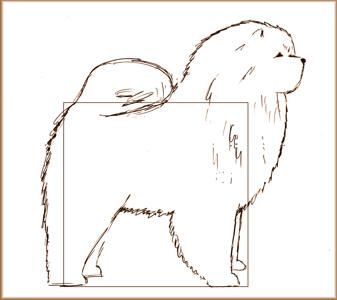
If breeders and judges work at regaining the correct overall skeletal balance that is an absolute necessity on a square, functional breed, such as the Chow Chow (Illustration 16), we will also stride ahead to regain a high prevalence of that millenniums old, beautiful, free, unique and energy efficient movement of our breed.
Illustration 16
Legend for illustrations:
Horizontal solid line – topline
Vertical solid line – point of sternum
Vertical dotted line – point of shoulder
Angled dotted line, front angulation – 110 - 120 degrees.
Wanting to publish these articles or link to them?
Some authors have given permission for these articles to be printed out for private free use internationally, both in national judges' training schemes and for private free education of individuals. However, all articles remain COPYRIGHT of the authors and no copies of these articles may be published in any way without written permission from the authors. For permission please contact the authors directly or please contact the webmaster.
On
the web, it will be appropriate to LINK to the articles which
originally appear on this website.
Acknowledgement of the articles' original appearance on this website
is appropriate and appreciated.
Breed Standards:
More Judging Articles:
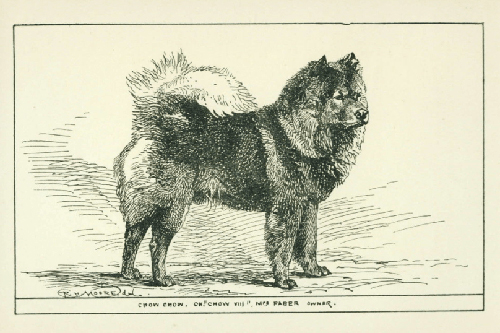 Learn more about the Chow Chow upon which the Breed standard is said to have been based.
Learn more about the Chow Chow upon which the Breed standard is said to have been based.
Learn about the Chow Chow's rich history on the Chow Chow Archives. This will help you understand the need for functional structure and moderate type.
